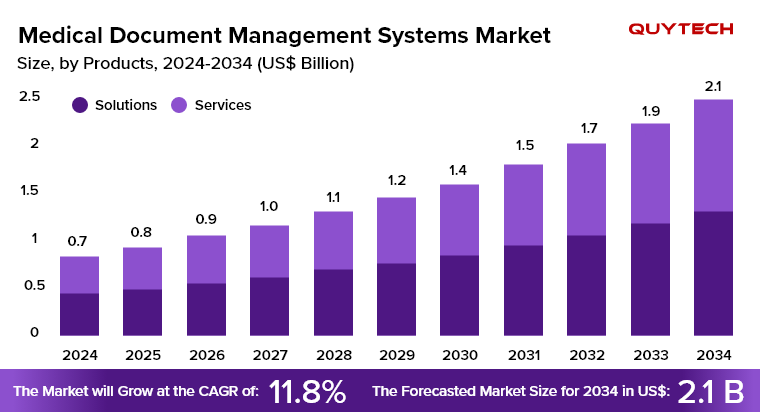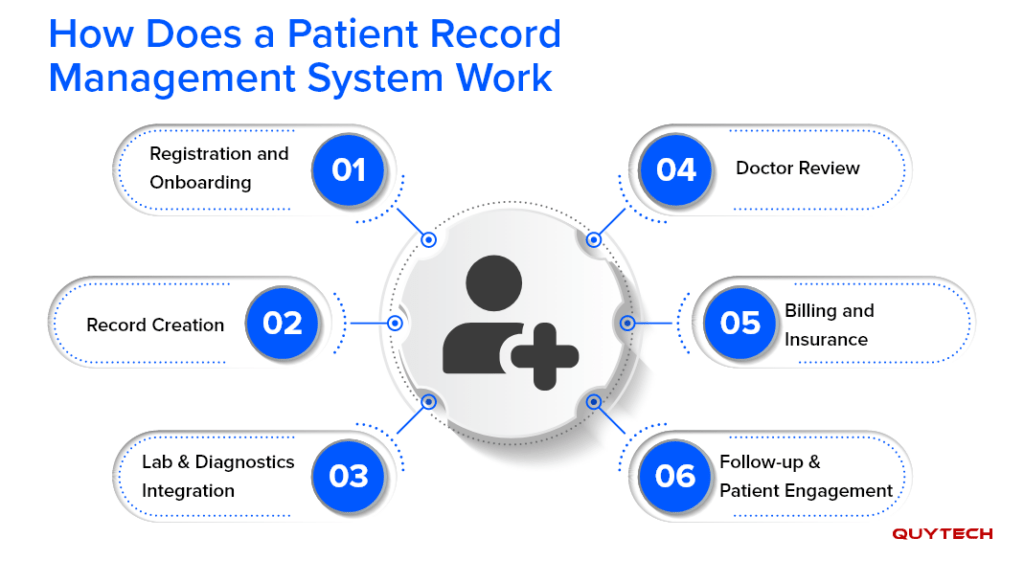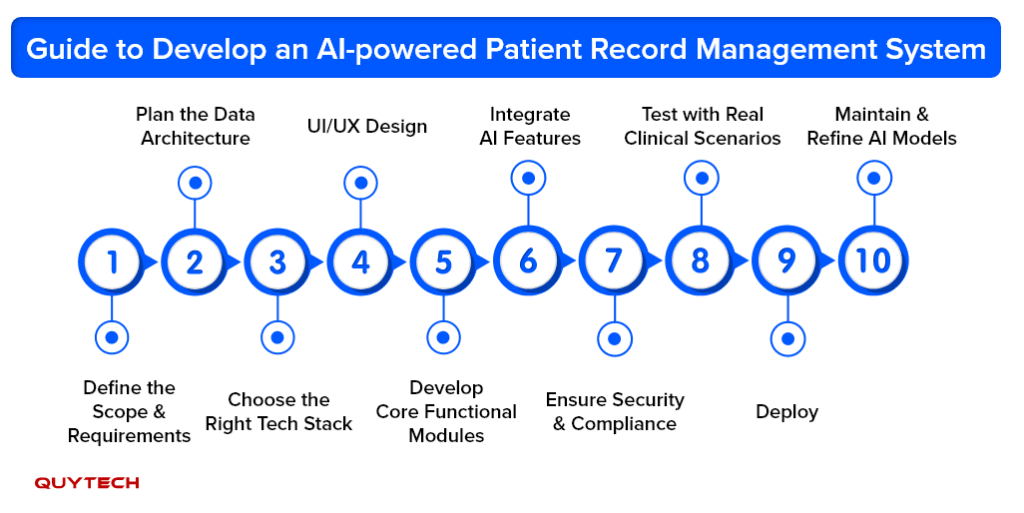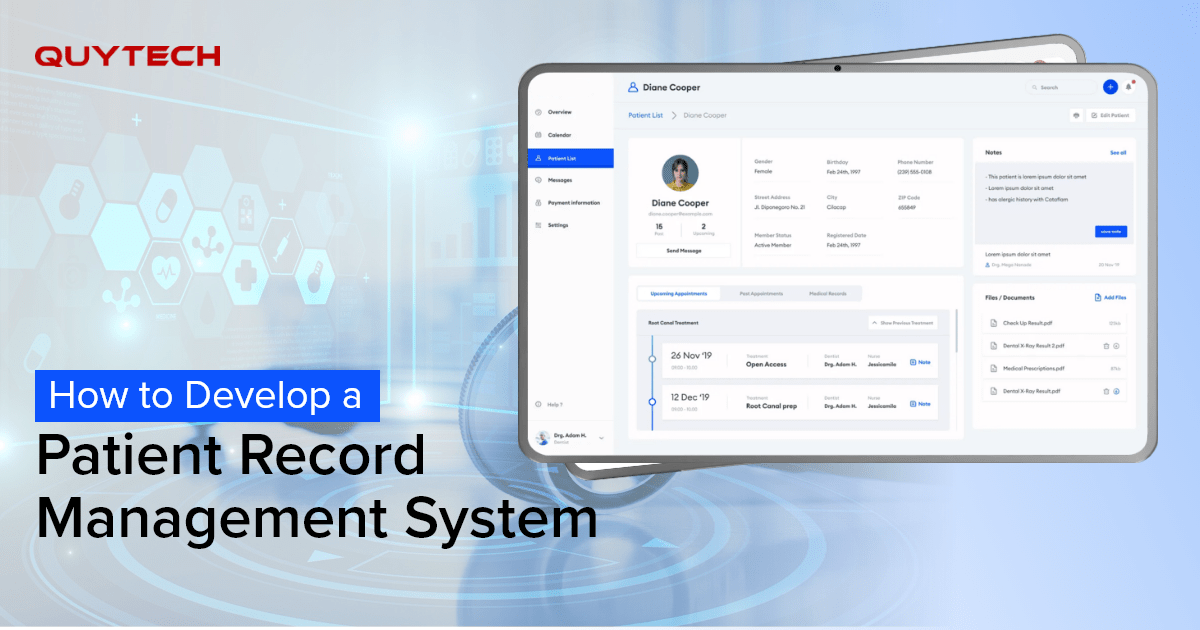Like other sectors, the healthcare industry is also undergoing tech transformations; however, there are many healthcare organizations that still suffer from inefficiencies due to the lack of proper record management systems. The paper-based record management system that most hospitals and healthcare facilities rely upon lacks basic security of documentation.
It paved the way for the development of an electronic record management system. This system brought significant improvements to the record management system, but still had some drawbacks, including the inability to analyze unstructured data, the absence of real-time access, and data duplication. This is where an AI-based patient record management system enters the scene. It works effectively by automating routine tasks, analyzing complex data, and providing real-time access and insights to the management.
This blog will guide you through the features, benefits, and development process of a patient record management system.

Patient Record Management System: Market Stats
- The market for patient record management systems is expected to grow rapidly at a 12.4% CAGR, reaching $32.7 billion by 2030.
- With the greatest revenue share of 63.5% in the medical record management systems market, the cloud-based sector is the leading player.
What is a Patient Record Management System?
A patient record system is a digital system that helps healthcare providers maintain a systematic and efficient record of patients. This system is an effective and fast way to store, manage, and retrieve records in real time. It helps doctors to access any patient file on their screen without a long wait time. It allows the administration to store all the data related to each patient in their electronic files. Documents saved through this system were safe and secure, and allowed patients to check their reports and book appointments online.
How AI Plays a Significant Role in the Patient Record Management System
When integrated with artificial intelligence, the working of a patient record management system becomes more streamlined and enhanced. It not only does what the basic patient record system does, but adds to it by analyzing and learning the data stored. It proactively gives insights to the management and contributes to improving the decision-making process.
AI for patient record management can even analyze the doctor’s notes and derive symptoms and diagnoses. It keeps track of the vital areas that need to be checked for patients and alerts the staff in case of any health-related uncertainty. When Integrated with AI, the record system can even go a step beyond and provide reports promptly without needing to enter keywords for searching. It is capable of taking voice commands and even assists with the billing procedures.
Read More: How Healthcare Apps Improve Patient-Doctor Communication?
Must-Have Features of a Patient Record Management System
To keep up with the growing technological advancements and facility preferences, a patient record management system comes with the following features:
Centralized Record Storage
This feature provides a centralized storage for all patient-related information, like medical history, diagnoses, prescriptions, etc. With the help of AI, it generates digital prescriptions with dosage instructions. Provides a platform for patients to monitor their progress.
Appointment Booking and Patient Communication Tools
AI for patient record management comes with a feature that allows patients to schedule appointments. The system sends automated reminders for appointments as well as follow-ups. It also offers a medium for connecting with the doctor for updates.
User Access Management
User access management handles who can access the data and how much of it can be accessed by each user. It also keeps a record of access information and editing history of the data. Along with these, it supervises data sharing and follows regulations regarding data safety.
Billing and Insurance
A patient record management system takes care of everything from billing, invoicing to processing insurance-related procedures. It maintains data accuracy, consistency, and autocodes diagnoses.
AI-powered Assistance
The record management system provides patients with real-time medicine reminders and updates on their health status. The system uses machine learning along with AI to grasp the patients’ health history and suggest treatment plans.
Speech Recognition
The speech recognition feature identifies the voice of the speaker and automatically retrieves their medical data. It also facilitates the doctors in providing prescriptions and orders simply by speaking.
How Does a Patient Record Management System Work
The patient record management system works as a centralized system providing storage, retrieval, and management of the data of the healthcare organization. The following shows the working mechanism of a patient record management system:

Registration and Onboarding
Registration begins when the patient visits the doctor, followed by onboarding. The digital system forms a unique ID with all the information like name, age, height, weight, contact, etc. AI supports by using facial and voice recognition to verify the identity faster.
Record Creation
The system stores the structured data digitally so that it is consistent and easy to search. AI works by suggesting diagnoses based on the symptoms and ensures data is accurate.
Lab and Diagnostics Integration
If the patient has any lab or diagnostic tests, then the digital system syncs the reports of the tests. Artificial intelligence analyzes the test results and provides appropriate suggestions.
Doctor Review
After conducting the tests, the doctor plans treatment based on the previous visits and test results. The patient record management system creates a dashboard and suggests drug alerts and treatment recommendations.
Billing and Insurance
After the completion of the treatment, the record system generates the bill and starts the insurance claim procedures. It creates invoices, and AI improves the accuracy of the billing and insurance process.
Follow-up and Patient Engagement
Post-discharge, the system manages follow-up and patient engagement by sending appointment, test, and report alerts. AI supports by personalizing the messages based on the condition or treatment plan.
Read More: How Predictive Analytics is Transforming the Healthcare Industry
Guide to Develop an AI-powered Patient Record Management System
Here’s a clear, step-by-step breakdown of how to build a modern Patient Record Management System:

Define the Scope and Requirements
Decide the target users and identify their roles in the patient record system. It determines user access based on their role and workflows. To secure the health information, it is essential to adhere to the regulations when working on this section.
Plan the Data Architecture
Planning the data structure mainly relies on how you will be storing the data of every patient. This includes deciding the architecture for both structured data, like vitals, diagnoses, etc., and personal data like the name, age, height, contact details of the patient, etc.
Choose the Right Tech Stack
This step includes selecting the right technology stack required to build the patient record management system. It includes deciding the requirements to work on the frontend, backend, database, etc. Ensure that the tech stack you choose supports the data you will be storing.
UI/UX Design
Design the user interface and user experience to create an easy-to-use interface. The interface should be user-friendly as it targets healthcare staff and patients as well.
Develop Core Functional Modules
This step includes building the core modules that make the system functional. It includes modules that perform registration, appointment booking, medical records, lab and imaging, digital prescription, billing, etc.
Integrate AI Features
After laying the digital foundation, start working on integrating artificial intelligence features into the system. Use natural language processing, AI models, speech recognition, and machine learning to integrate smart assistance features that adapt to the existing and new data regularly.
Ensure Security and Compliance
Ensure security compliance by controlling which users can access how much data in the system. Incorporate encryption and edit history access to keep the data changes in check.
Test with Real Clinical Scenarios
Test the system in real situations to ensure smooth operation of the system and check for deviations. Let users test the system and give feedback based on their experience, and work on improvements if needed.
Deploy
Deploy the patient record management system at a few departments first. Look out for any points of improvement and then launch on the bigger network after fixing the issues.
Maintain and Refine AI Models
After deploying, keep updating and refining the system from time to time to ensure that it works smoothly. Track the accuracy and train the AI models regularly.
While the steps are easy to understand, building the patient record system requires expertise and resources. If you lack the resources and expertise required to build an AI-powered patient record management system, then you can hire developers. They can help bring life to your ideas with their domain knowledge.

Benefits of a Patient Record Management System
Implementing a patient record system is not just about storing files; it does much more than that. Here are some core advantages of an AI-powered record management system:
Improved Clinical Decision-Making
It allows the doctors to make quick decisions as all the required information is easily accessible. It also provides AI-supported insights that give treatment suggestions based on the patient’s lab results and test reports.
Reduced Medical Errors
With the support of artificial intelligence, the patient record management system works seamlessly and accurately. This ensures that no errors are made in the diagnoses, prescriptions, and test results.
Faster Administrative Workflows
The digitally maintained patient record system reduces paperwork and slow administrative workflows. It allows users to locate files and process billings, invoices, and insurance without hassle.
Enhanced Patient Experience
Patient record management system offers the patients a medium to access their health records, be it past ones or upcoming appointments. This system also provides timely reminders and suggestions to the patients regarding their medicines, appointments, tests, and reports.
Better Coordination Across Departments
Real-time syncing and access allow multiple users to access the same updated files. This helps in creating better coordination between different departments at the same time.
Data Security and Audit Control
An AI-powered patient record management system maintains regulatory compliance regarding data safety. It incorporates end-to-end encryption, access control, and activity monitoring to provide enhanced safety.
Real World Examples
Here are some real-world examples of healthcare providers who utilized a patient record management system to maintain patient records:
- HealthDox: It is a healthcare patient record management system designed for healthcare providers. It helps in managing complete records and provides security for the same.
- iCare Health Information System: iCare is a cloud-based patient record management system built for hospitals and multi-specialty clinics. It offers a centralised system for recording patient records along with chart documentation and access to control data handling.
- PatientClick PRMS: PatientClick PRMS is a customisable record management system that provides document management along with real-time lab result access and a secure communication portal.
Read More: AI in Remote Patient Monitoring: Improving Healthcare Accessibility and Convenience
How Quytech can Help you Develop a Patient Record Management System
Building a smart, secure, reliable, and AI-powered patient record management system requires a lot more than just resources. It requires expertise in the domain along with proper architecture and integration. With multiple successful healthcare projects like Conpetence, We Care, Patient App, etc., Quytech can bring life to your vision.
With a team full of expert developers and AI engineers, Quytech provides you with personalized solutions that cater to your requirements as well as your domain. Our specialized solutions help you at every step, be it deciding the type of storage system for your patient record management system or deploying it in a live environment.
Final Thoughts
Managing patient data in a healthcare organization plays a significant role in analyzing a patient’s condition, which is possible only when there’s a reliable system to manage the documents. From basic document management to syncing real-time changes, all this is possible only with the help of an effective patient record management system.
Upgrading to an AI-based patient record management system is necessary to build an efficient, accurate, and accessible system. It provides better decision-making, reduced errors, faster administration, and better departmental coordination. It not only assists the staff but also creates a patient-centric solution.
FAQ’s
A patient record management system is similar to an EHR system, but it has more features. EHR mainly focuses on keeping a record of clinical data, but the patient record has many more features, like billing, invoicing, insurance, etc.
Yes, small clinics can also opt for an AI-based patient record management system. It will be a good option as it is more efficient and also feature-packed.
A patient record management system is very beneficial to the patients, as they can access their medical data easily. They can also schedule appointments and receive health-related suggestions.
AI plays a significant role as it integrates different structured and unstructured data to provide health-related suggestions to the patients. It automatically syncs the new updates into the existing records and alerts the patients for their appointments.


